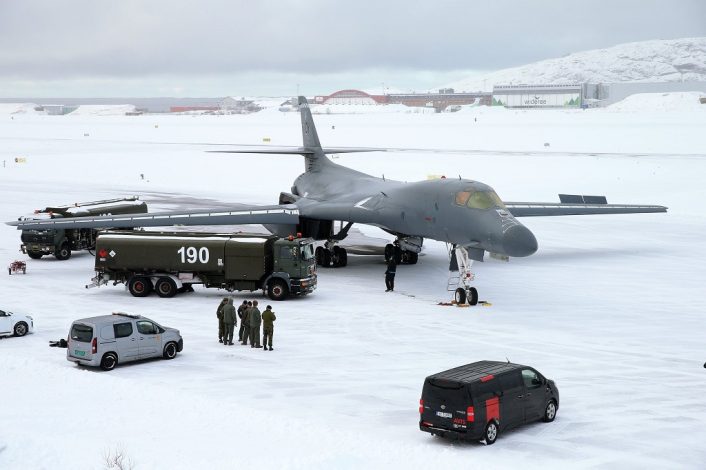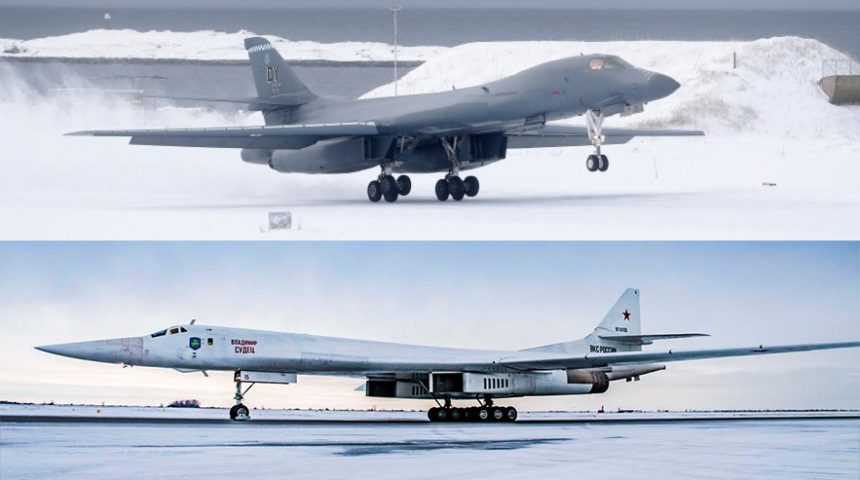Both the U.S. and Russian Air Force have released images of their bombers operating on snowy airfields recently.
A B-1B Lancer bomber of the U.S. Air Force landed for the first time at Bodø Main Air Station in northern Norway, marking the bomber’s first landing at an airbase above the Artic Circle. The aircraft, which can be identified in the photos as the 7th Operations Group’s flagship 85-0073, is one of the four bombers deployed last month from Dyess Air Force Base, Texas, to Ørland Air Force Station, Norway, as part of a Bomber Task Force Europe mission.
The first, historic landing was carried out during a training mission, dubbed Agile Condor, on Mar. 8, 2021 which involved Close Air Support training alongside U.S. Special Operations Forces members, supporting the training of Norwegian and Swedish Joint Terminal Attack Controllers (JTAC). During the mission the bomber also integrated with four Swedish JAS-39 Gripen fighter aircraft.
Yesterday Chief of Defence Eirik Kristoffersen visited Ørland Main Airstation and U.S Bomber Task Force (BTF). They are in Norway to train with The Norwegian Armed Forces. Together with the Royal Norwegian Air Force they are doing joint training. pic.twitter.com/EAAR14JfgD
— Royal Norwegian Air Force (@Luftforsvaret) March 10, 2021
“It’s not every day that our bomber has the chance to play such a prominent role in training ally and partner JTACs,” said Gen. Jeff Harrigian, U.S. Air Forces in Europe-Air Forces Africa commander. “Opportunities to train alongside our allies, partners and U.S. Special Operations Forces in forward locations makes us the rapid, resilient and ready force we need to be.”
As stated in the Royal Norwegian Air Force’s press release, the bomber experienced real winter conditions in Bodø. As a matter of fact, because of the snow, the airport was closed for three quarters of an hour, with the BONE (as the B-1 is dubbed by its aircrews) circling in a holding pattern overhead, while the runway was freed from the dense snow so the aircraft could land safely.
After the landing, the B-1 conducted a “warm-pit refuel”, during which the crew stayed in the cockpit while aircraft maintainers with the 9th Expeditionary Bomb Squadron refueled the bomber. “A warm-pit is a refueling operation where the aircraft engines are shut down while the auxiliary power units remain on without the aircrew exiting the jet,” said the 9th EBS maintenance lead at Bodø AFS. “This is done to reduce the time that the aircraft is on the ground and allows us to get the jet airborne faster.”

This operation is very similar to the better known hot-pit refuel, with the only difference being that during the hot-pit refuel the engines are still running and not shut down. A USAFE public relations officer hinted in the comments in the command’s official Facebook page that a training mission involving a hot-pit refuel may happen soon.
“We are making our operations less predictable,” said the Bomber Task Force project officer. “Warm-pits do not require extensive advanced coordination, allowing us to land at any airfield with a long enough runway, reload, and get back in the air as fast as possible.”
According to the USAF press release, Agile Condor demonstrated the 9th EBS’ ability to perform operations in an unpredictable manner from unfamiliar locations as part of the Agile Combat Employment. “If the adversary does not know what bases we will be operating from, they will not be able to target bomber bases in advance,” said the project officer. “Utilizing ACE makes us unpredictable, giving us the strategic edge to forward deploy to any airfield at any time.”
The Russians “responded” with flights of Tu-160 and Tu-95MS bombers in snowy winter conditions from Engels airfield, in the Saratov region. At least 10 long-range aviation crews made of officers the command staff of the aviation units, regiment and division based at Engels worked on takeoffs and landings, air-to-air refueling, formation flying and low altitude flight during day and night.
Экипажи дальней авиации провели командирские полеты на стратегических ракетоносцах Ту-160 в Саратовской области. С аэродрома Энгельс под руководством командира соединения более 10 экипажей подняли в небо воздушные суда #Минобороны #ВВС #ВКС #ДальняяАвиация #Ту160 #Самолеты pic.twitter.com/Il0ovKvTLd
— Минобороны России (@mod_russia) March 11, 2021
More interestingly, another exercise was held over the Baltic Sea. At least 10 Su-27s of the Russian Navy’s Baltic Fleet performed a scramble and mock intercept of “enemy aircraft” violating the borders of the Russian Federation in an attempt to launch a missile and bomb strike on strategic military targets. The Flankers identified the aircraft “of a conditional enemy” and simulated shooting them down with “electronic launches of guided missiles”.
A similar exercise was held over Eastern Russia, in the Chukotka autonomous district. The MiG-31BMs of the Russian Navy’s Pacific Fleet performed a simulated intercept of a mock enemy (another MiG-31) over the Artic Circle, which was flying “at supersonic speed and at an altitude of about 20 kilometers” (about 65.600 ft). Considering that the Mach 2.83-capable Foxhound has a service ceiling of 25 km (82,000 ft), that report might not be totally unfounded.
Back to the BONEs (from B-One), as you may already know from our previous articles here at The Aviationist, the four B-1B Lancers from the 7th Bomb Wing arrived at Ørland Air Force Station, home also of the RNoAF F-35s, about two weeks ago. A few days after their arrival, the bombers flew their first tactical integration mission with a Norwegian F-35A and naval assets. A week later, two B-1Bs flew over Lithuania, Latvia and Estonia while integrating with Danish F-16s, Polish F-16s and Baltic Air Policing Eurofighter Typhoons belonging to the Italian and German Air Force.









